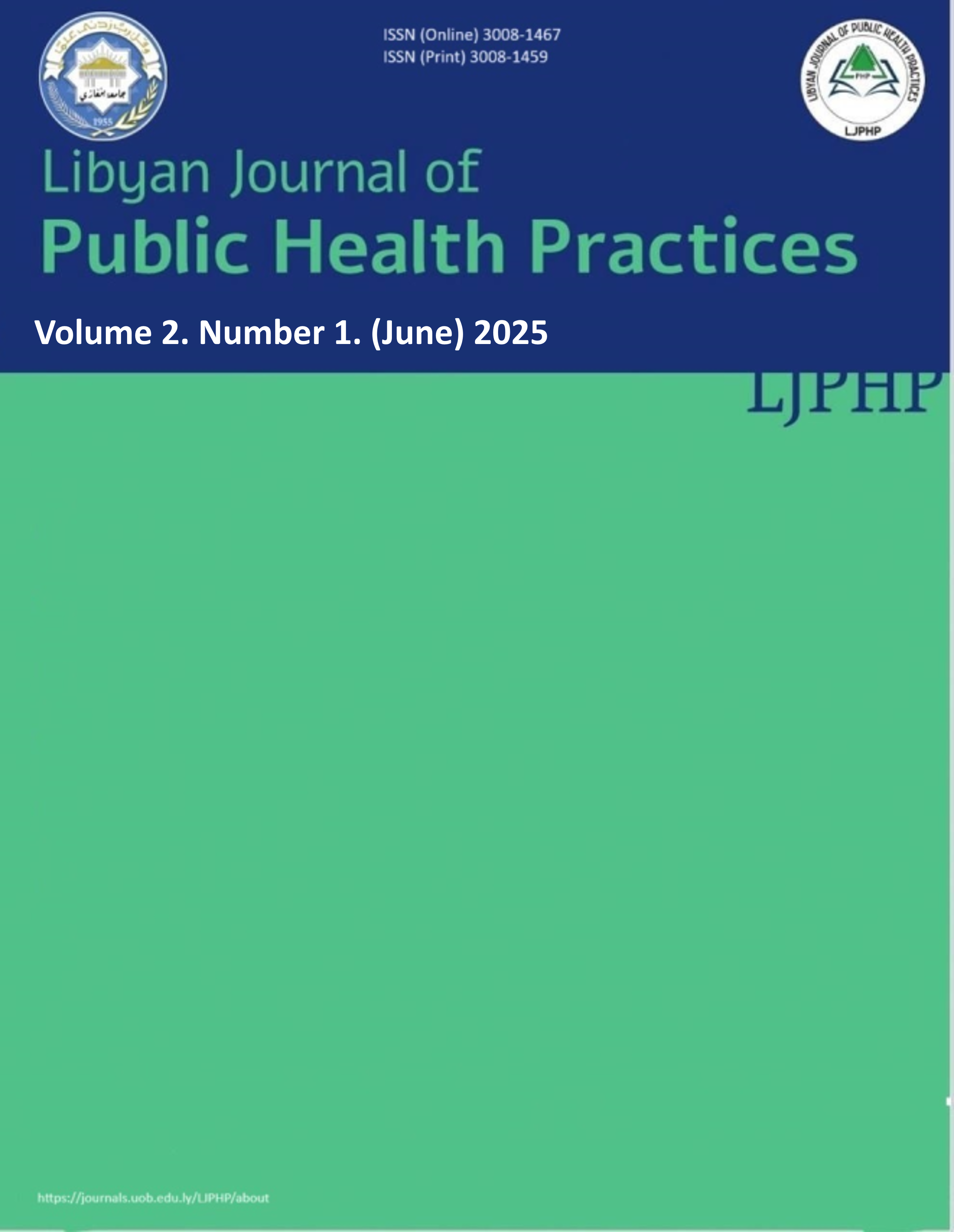Prevalence of multi-ingredient pre-workout ergogenic and protein supplement use and effect on kidney function among university students and athletes in Benghazi, Libya
DOI:
https://doi.org/10.37376/ljphp.v2i1.7346Keywords:
Multi-Ingredient Pre-Workout Ergogenic Supplements, Athletes, University students, Kidney function, ProteinAbstract
The use of multi-ingredient pre-workout supplements (MIPS) is becoming increasingly common among university students and athletes, driven by the perceived benefits of increased energy, endurance, and muscle performance. However, the overuse of protein, particularly in this context, raises concerns regarding renal health. Few studies have addressed this issue in North African populations. A cross-sectional study was conducted among 244 students and athletes in Benghazi (56.6% males, 43.4% females). Data were collected via online questionnaire and analyzed using SPSS v22. A subgroup (n=30) underwent renal function testing, including serum urea, creatinine, uric acid, and electrolytes. Chi-square tests and Pearson correlations were used (P < 0.05).
Male participants reported significantly higher supplement use (71.02%) than females (41.51%, P < 0.001). Nevertheless, (37.68%) of males compared to females (42.45%) reported that they would consume ergogenic supplements if they were encouraged by their coaches. Protein supplement use was positively associated with income (r = 0.229, P = 0.001). As for the detrimental effects on kidney function, renal testing indicated elevated urea and uric acid among MIPS users, suggesting potential kidney strain.
MIPS are widely used among students and athletes in Benghazi, with notable gender differences in usage and perception. MIPS potential detrimental effects on kidney function raise concerns about safety and health risks among younger users. A deeper understanding of these supplements' risks and benefits is crucial for informed decision-making. This study is among the first in Libya to examine the physiological effects of MIPS use, offering critical insight into an under-researched population
References
Beyer KS, Gadsden M, Patterson-Zuber P, Gonzalez AM. A single dose multi-ingredient pre-workout supplement enhances upper body resistance exercise performance. Front Nutr. 2024;11:1323408.
Harty PS, Zabriskie HA, Erickson JL, Molling PE, Kerksick CM, Jagim AR. Multi-ingredient pre-workout supplements, safety implications, and performance outcomes: A brief review. J Int Soc Sports Nutr. 2018;15(1):41.
Figueiredo C, Lira F, Rossi F, et al. Multi-ingredient pre-workout supplementation changes energy system contribution and improves performance during high-intensity intermittent exercise in physically active individuals: A double blind and placebo controlled study. J Int Soc Sports Nutr. 2020;17.
Fredholm B, Yang J, Wang Y. Low, but not high, dose caffeine is a readily available probe for adenosine actions. Mol Aspects Med. 2016;55.
McLellan TM, Caldwell JA, Lieberman HR. A review of caffeine's effects on cognitive, physical and occupational performance. Neurosci Biobehav Rev. 2016;71:294-312.
Alasmari F. Caffeine induces neurobehavioral effects through modulating neurotransmitters. Saudi Pharm J. 2020;28(4):445-451.
Ryu S, Choi SK, Joung SS, et al. Caffeine as a lipolytic food component increases endurance performance in rats and athletes. J Nutr Sci Vitaminol (Tokyo). 2001;47(2):139-146.
Ferreira LHB, Forbes SC, Barros MP, et al. High doses of caffeine increase muscle strength and calcium release in the plasma of recreationally trained men. Nutrients. 2022;14(22).
Van Schaik L, Kettle C, Green R, et al. Effects of caffeine on brown adipose tissue thermogenesis and metabolic homeostasis: A review. Front Neurosci. 2021;15:621356.
Cruzat VF, Krause M, Newsholme P. Amino acid supplementation and impact on immune function in the context of exercise. J Int Soc Sports Nutr. 2014;11(1):61.
Guest NS, VanDusseldorp TA, Nelson MT, et al. International society of sports nutrition position stand: Caffeine and exercise performance. J Int Soc Sports Nutr. 2021;18(1):1.
Culbertson JY, Kreider RB, Greenwood M, Cooke M. Effects of beta-alanine on muscle carnosine and exercise performance: A review of the current literature. Nutrients. 2010;2(1):75-98.
Derave W, Everaert I, Beeckman S, Baguet A. Muscle carnosine metabolism and beta-alanine supplementation in relation to exercise and training. Sports Med. 2010;40(3):247-263.
Ialongo D, Tudino V, Arpacioglu M, et al. Synergistic effects of caffeine in combination with conventional drugs: Perspectives of a drug that never ages. Pharmaceuticals (Basel). 2023;16(5).
Matthews JJ, Artioli GG, Turner MD, Sale C. The physiological roles of carnosine and β-alanine in exercising human skeletal muscle. Med Sci Sports Exerc. 2019;51(10):2098-2108.
Huerta Ojeda Á, Tapia Cerda C, Poblete Salvatierra MF, et al. Effects of beta-alanine supplementation on physical performance in aerobic-anaerobic transition zones: A systematic review and meta-analysis. Nutrients. 2020;12(9).
Ostfeld I, Hoffman JR. The effect of β-alanine supplementation on performance, cognitive function and resiliency in soldiers. Nutrients. 2023;15(4).
Ashtary-Larky D, Bagheri R, Ghanavati M, et al. Effects of beta-alanine supplementation on body composition: A grade-assessed systematic review and meta-analysis. J Int Soc Sports Nutr. 2022;19(1):196-218.
de Poli RAB, Roncada LH, Malta ES, et al. Creatine supplementation improves phosphagen energy pathway during supramaximal effort, but does not improve anaerobic capacity or performance. Front Physiol. 2019;10:352.
Antonio J, Candow DG, Forbes SC, et al. Common questions and misconceptions about creatine supplementation: What does the scientific evidence really show? J Int Soc Sports Nutr. 2021;18(1):13.
Wax B, Kerksick CM, Jagim AR, et al. Creatine for exercise and sports performance, with recovery considerations for healthy populations. Nutrients. 2021;13(6).
Herda TJ, Ryan ED, Stout JR, Cramer JT. Effects of a supplement designed to increase ATP levels on muscle strength, power output, and endurance. J Int Soc Sports Nutr. 2008;5:3.
Wu SH, Chen KL, Hsu C, et al. Creatine supplementation for muscle growth: A scoping review of randomized clinical trials from 2012 to 2021. Nutrients. 2022;14(6).
Kruszewski M, Merchelski M, Kruszewski A, et al. Effects of multi-ingredient pre-workout supplement and caffeine on bench press performance: A single-blind cross-over study. Nutrients. 2022;14(9).
Liu Y, Abdullah BB, Abu Saad HB. Effects of high-intensity interval training on strength, speed, and endurance performance among racket sports players: A systematic review. PLoS One. 2024;19(1):e0295362.
Waldron M, Whelan K, Jeffries O, et al. The effects of acute branched-chain amino acid supplementation on recovery from a single bout of hypertrophy exercise in resistance-trained athletes. Appl Physiol Nutr Metab. 2017;42(6):630-636.
Kaspy MS, Hannaian SJ, Bell ZW, et al. The effects of branched-chain amino acids on muscle protein synthesis, muscle protein breakdown and associated molecular signalling responses in humans: An update. Nutr Res Rev. 2023:1-14.
Norton LE, Layman DK. Leucine regulates translation initiation of protein synthesis in skeletal muscle after exercise. J Nutr. 2006;136(2):533S-537S.
Tipton KD, Hamilton DL, Gallagher IJ. Assessing the role of muscle protein breakdown in response to nutrition and exercise in humans. Sports Med. 2018;48(Suppl 1):53-64.
AbuMoh'd MF, Matalqah L, Al-Abdulla Z. Effects of oral branched-chain amino acids (BCAAs) intake on muscular and central fatigue during an incremental exercise. J Hum Kinet. 2020;72:69-78.
Newsholme EA, Blomstrand E. Branched-chain amino acids and central fatigue. J Nutr. 2006;136(1 Suppl):274S-276S.
Zhang S, Zeng X, Ren M, et al. Novel metabolic and physiological functions of branched chain amino acids: A review. J Anim Sci Biotechnol. 2017;8:10.
López-Torres O, Rodríguez-Longobardo C, Escribano-Tabernero R, et al. Hydration, hyperthermia, glycogen, and recovery: Crucial factors in exercise performance—a systematic review and meta-analysis. Nutrients. 2023;15(20).
Khemtong C, Kuo CH, Chen CY, et al. Does branched-chain amino acids (BCAAs) supplementation attenuate muscle damage markers and soreness after resistance exercise in trained males? A meta-analysis of randomized controlled trials. Nutrients. 2021;13(6).
Naderi A, de Oliveira EP, Ziegenfuss TN, Willems MT. Timing, optimal dose and intake duration of dietary supplements with evidence-based use in sports nutrition. J Exerc Nutrition Biochem. 2016;20(4):1-12.
Mendoza MF, Sulague RM, Posas-Mendoza T, Lavie CJ. Impact of coffee consumption on cardiovascular health. Ochsner J. 2023;23(2):152-158.
Grajeda-Iglesias C, Aviram M. Specific amino acids affect cardiovascular diseases and atherogenesis via protection against macrophage foam cell formation: Review article. Rambam Maimonides Med J. 2018;9(3).
Chabaiki I, Bekadi A, Bechikh M. Sports supplements: Use, knowledge, and risks for Algerian athletes. North Afr J Food Nutr Res. 2020;4:231-239.
Allehdan S, Hasan M, Perna S, et al. Prevalence, knowledge, awareness, and attitudes towards dietary supplements among Bahraini adults: A cross-sectional study. Food Prod Process Nutr. 2023;5(1):54.
Chen X. Explore athletes' sports attitude and its influence on mental health. Heliyon. 2024;10(9):e30734.
Fu L, Shi Y, Li S, et al. Healthy diet-related knowledge, attitude, and practice (KAP) and related socio-demographic characteristics among middle-aged and older adults: A cross-sectional survey in southwest China. Nutrients. 2024;16(6). doi:10.3390/nu16060869
Jovanov P, Đorđić V, Obradović B, et al. Prevalence, knowledge and attitudes towards using sports supplements among young athletes. J Int Soc Sports Nutr. 2019;16(1):27.
Jagim AR, Camic CL, Harty PS. Common habits, adverse events, and opinions regarding pre-workout supplement use among regular consumers. Nutrients. 2019;11(4).
Nelson A, Camic CL, Foster C, et al. Supplementation with a multi-ingredient pre-workout supplement does not augment resistance training adaptations in females. Int J Exerc Sci. 2019;12(2):187-202.
Almutairi KM, Alonazi WB, Vinluan JM, et al. Health promoting lifestyle of university students in Saudi Arabia: A cross-sectional assessment. BMC Public Health. 2018;18(1):1093.
Jawed S, Tariq S, Jamil Z, et al. Life style practices and health risk behaviors of medical students: A cross sectional study. J Bahria Univ Med Dent Coll. 2018;8.
Hailu GN, Berhe H, Siyoum D. Assessment of healthy diet and physical activity among students of Mekelle University, northern Ethiopia: A cross-sectional study. Nutr Diet Suppl. 2021;13:103-112.
Harty PS, Zabriskie HA, Erickson JL, et al. Multi-ingredient pre-workout supplements, safety implications, and performance outcomes: A brief review. J Int Soc Sports Nutr. 2018;15(1):41.
Knapik JJ, Steelman RA, Hoedebecke SS, Austin KG, Farina EK, Lieberman HR. Prevalence of dietary supplement use by athletes: Systematic review and meta-analysis. Sports Med. 2016;46(1):103-123.
Maughan RJ, Depiesse F, Geyer H. The use of dietary supplements by athletes. J Sports Sci. 2007;25(Suppl 1):S103-S113.
Goston JL, Correia MI. Intake of nutritional supplements among people exercising in gyms and influencing factors. Nutrition. 2010;26(6):604-611.
Aljaloud SO, Ibrahim SA. Use of dietary supplements among professional athletes in Saudi Arabia. J Nutr Metab. 2013;2013:245349.
Bailey RL, Gahche JJ, Miller PE, Thomas PR, Dwyer JT. Why US adults use dietary supplements. JAMA Intern Med. 2013;173(5):355-361.
Tian HH, Ong WS, Tan CL. Nutritional supplement use among university athletes in Singapore. Singapore Med J. 2009;50(2):165-172.
Froiland K, Koszewski W, Hingst J, Kopecky L. Nutritional supplement use among college athletes and their sources of information. Int J Sport Nutr Exerc Metab. 2004;14(1):104-120.
Huang SH, Johnson K, Pipe AL. The use of dietary supplements and medications by Canadian athletes at the Atlanta and Sydney Olympic Games. Clin J Sport Med. 2006;16(1):27-33.
Giannopoulou I, Noutsos K, Anastasiou CA, et al. Consumption of nutritional supplements among gym users in Greece: A cross-sectional study. Nutrients. 2022;14(18):3744.
El Khoury D, Antoine-Jonville S. Intake of nutritional supplements among people exercising in gyms in Beirut city. J Nutr Metab. 2012;2012:703490.
Mettler S, Bosshard JV. Development and validation of a questionnaire assessing the motives for the use of nutritional supplements. J Int Soc Sports Nutr. 2015;12:34.
Perkin O, Kavanagh D, Torondel B, et al. Dietary supplement use among adolescents in the UK: Prevalence, characteristics and associations with socio-demographic factors. Br J Nutr. 2023;129(4):631-640.
Chiba T, Sato Y, Suzuki S, Umegaki K. Use of dietary supplements by Japanese college students: A cross-sectional survey. Nutrients. 2019;11(2):439.
Downloads
Published
How to Cite
Issue
Section
License
Copyright (c) 2025 Libyan Journal of Public Health Practices

This work is licensed under a Creative Commons Attribution-NonCommercial-NoDerivatives 4.0 International License.












